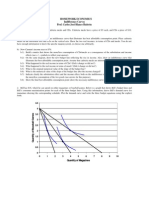01 Practice Problems Social Welfare
01 Practice Problems Social Welfare
Uploaded by
ozdolCopyright:
Available Formats
01 Practice Problems Social Welfare
01 Practice Problems Social Welfare
Uploaded by
ozdolCopyright
Available Formats
Share this document
Did you find this document useful?
Is this content inappropriate?
Copyright:
Available Formats
01 Practice Problems Social Welfare
01 Practice Problems Social Welfare
Uploaded by
ozdolCopyright:
Available Formats
Social Welfare Practice Problems
While you wont need to hand these problems in, there will be a short, in-class quiz based on these problems or problems very similar to them. You can find a partial answer key posted on the course webpage. 1) Suppose Adam and Eve have identical utility functions as described in the following table: Number of Apples 0 1 2 3 4 5 6 7 8 9 10 Marginal Utility ---10 9 8 7 6 5 4 3 2 1 Total Utility 0 10 19 27 34 40 45 49 52 54 55
When answering these questions, you may find it helpful to carefully draw utility possibility frontier and social indifference curves. A) Suppose the economy can only produce ten apples. Sketch the utility possibility frontier, putting Adams utility on the horizontal axis and Eves on the vertical. B) If you take a utilitarian view (i.e., SW = UA + UE), which allocation of apples maximizes social welfare? C) If you take a Rawlsian view (i.e., SW = min{UA, UE}), which allocation of apples maximizes social welfare? D) Assume Adam is initially endowed with two apples, while Eve is endowed with the remaining eight. Further, assume that for every two apples taken away from Eve, Adam only gets one (the other being lost in the redistribution process). Mark the initial endowment point on your UPF diagram from Problem 1, and on the same diagram draw the new UPF. Allowing for redistribution, which allocation maximizes welfare under a utilitarian social welfare function? Which maximizes welfare under a Rawlsian social welfare function?
2) Suppose Bonnie and Clyde make up a two-person economy where the only two goods consumed are bullets and whiskey. Bonnie and Clydes preferences and the allocation of the two goods are as you see here: 0Clyde A
A) Shade in the combinations of bullets and whiskey that would leave both Bonnie and Clyde at least as well off as they are at the initial allocation (point A). B) Draw a new allocation that would leave Bonnie as well off as she can possibly be without making Clyde any worse off. Label this point B. Draw new indifference curves for Bonnie and/or Clyde as necessary. C) Draw a new allocation that would leave Clyde as well off as he can possibly be without making Bonnie any worse off. Label this point C. Draw new indifference curves for Bonnie and/or Clyde as necessary. D) Draw a contract curve showing all of the allocations of bullets and whiskey that would represent Pareto improvements over point A. [Hint: Points B and C will play an important role here.] E) Suppose Bonnies MRS at point A is 10, while Clydes is 1/10. Give a numerical example of whiskey-and-bullets exchange that would make both Bonnie and Clyde better off. Briefly describe the intuition behind your answer.
Whiskey
ICClyde
ICBonnie
0Bonnie
Bullets
4) Now imagine that Bonnie and Clyde are part of a production economy (i.e., theyre not limited to simply trading a fixed number of bullets and bottles of whiskey but can choose to produce more or less or either good. Explain why point D isnt Pareto optimal if MRSBonnie = MRSClyde = 2 while the marginal rate of transformation (MRT) at point 0Clyde is 1/2. Whiskey 0Clyde
D ICBonnie ICClyde
PPF |slope| = MRT
0Bonnie
Bullets
You might also like
- Modern Portfolio Theory and Investment Analysis, 6th SolutionsDocument153 pagesModern Portfolio Theory and Investment Analysis, 6th SolutionsXiaohe Chen90% (10)
- Elton Gruber 7e Solution ManualDocument139 pagesElton Gruber 7e Solution ManualSarjeel Ahsan Niloy50% (4)
- HW 1Document4 pagesHW 1Ricardo TabladaNo ratings yet
- Olympiad Sample Paper 2: Useful for Olympiad conducted at School, National & International levelsFrom EverandOlympiad Sample Paper 2: Useful for Olympiad conducted at School, National & International levelsRating: 5 out of 5 stars5/5 (4)
- Problem Set 1Document9 pagesProblem Set 1Sankar AdhikariNo ratings yet
- Problem Set 3Document2 pagesProblem Set 3iannaNo ratings yet
- Practice Problem Set 2 With AnswersDocument12 pagesPractice Problem Set 2 With AnswersJoy colabNo ratings yet
- Olympiad Sample Paper 6: Useful for Olympiad conducted at School, National & International levelsFrom EverandOlympiad Sample Paper 6: Useful for Olympiad conducted at School, National & International levelsRating: 4 out of 5 stars4/5 (8)
- Old Test PaperDocument10 pagesOld Test PaperNR0% (1)
- CH 2Document17 pagesCH 2Daniiar KamalovNo ratings yet
- ECON 210 Professor GuseDocument8 pagesECON 210 Professor GuseJosh2002No ratings yet
- Introduction To Optimization MS&E 111/MS&E 211/ENGR 62 HW2 Course Instructor: Ashish GoelDocument3 pagesIntroduction To Optimization MS&E 111/MS&E 211/ENGR 62 HW2 Course Instructor: Ashish GoelMuhammad Raza RafiqNo ratings yet
- ECON 201 - Problem Set 2Document3 pagesECON 201 - Problem Set 2KemalNo ratings yet
- Problem Set 1Document2 pagesProblem Set 1alexking573No ratings yet
- MIT14 01SCF11 Assn03Document3 pagesMIT14 01SCF11 Assn03Vijaya AgrawaNo ratings yet
- HW5 - 2020 2 PDFDocument3 pagesHW5 - 2020 2 PDFPavel SmirnovNo ratings yet
- Instructions: Students May Work in Groups On The Problem Set. Each Student Must Turn in His/her OWNDocument16 pagesInstructions: Students May Work in Groups On The Problem Set. Each Student Must Turn in His/her OWNHamna AzeezNo ratings yet
- Consumer Choice ProblemsDocument22 pagesConsumer Choice ProblemsRajeev ShahiNo ratings yet
- Assignment 1 (ECN 511)Document4 pagesAssignment 1 (ECN 511)Mhmd KaramNo ratings yet
- ECONONE Second Long Exam Reviewer Term 2, AY2015-16Document2 pagesECONONE Second Long Exam Reviewer Term 2, AY2015-16louise carinoNo ratings yet
- B Des Sample Paper 2016Document12 pagesB Des Sample Paper 2016SahajPuriNo ratings yet
- Econ 2 Deg Exam 2016 - 2017 - FINAL PDFDocument11 pagesEcon 2 Deg Exam 2016 - 2017 - FINAL PDFAriel WangNo ratings yet
- ps1 - MicroeconomicsDocument10 pagesps1 - MicroeconomicsLEENNo ratings yet
- Tutorial 3 Worksheet PDFDocument4 pagesTutorial 3 Worksheet PDFTapiwaNicholasNo ratings yet
- Review1answers - Microeconomic AnalysisDocument4 pagesReview1answers - Microeconomic AnalysisSalsa FaniaNo ratings yet
- UCLA ECON148 Pset2Document3 pagesUCLA ECON148 Pset2k8pp6hfz89No ratings yet
- MIT - Solution Set 3Document6 pagesMIT - Solution Set 3MiiwKotiramNo ratings yet
- Logical Building ExerciseDocument12 pagesLogical Building Exercisegadad513No ratings yet
- PS2 SolsDocument12 pagesPS2 SolsMatthew ZukowskiNo ratings yet
- TextDocument60 pagesTextapi-274031459No ratings yet
- Problem Set 1 Solution Key ECN 131Document4 pagesProblem Set 1 Solution Key ECN 131royhan 312No ratings yet
- Final ExamDocument2 pagesFinal ExamblacmsNo ratings yet
- 2700 Advance MicroeconomicsDocument3 pages2700 Advance Microeconomicsmeelas123No ratings yet
- ECON111 - Individual-Assignment-02- NGUYỄN THÙY DƯƠNGDocument6 pagesECON111 - Individual-Assignment-02- NGUYỄN THÙY DƯƠNGntdalhp21271No ratings yet
- Homework 2Document2 pagesHomework 2Isoken Kenny Igbinedion0% (1)
- 1Document12 pages1Anshuman PrakashNo ratings yet
- Modern Portfolio Theory and Investment Analysis, 7th EditionDocument11 pagesModern Portfolio Theory and Investment Analysis, 7th EditionsudhakarhereNo ratings yet
- Assignemnt 1-Winter2023Document2 pagesAssignemnt 1-Winter2023Omotara YusufNo ratings yet
- Microeconomics Theory and Applications 12th Edition Browning Test Bank DownloadDocument37 pagesMicroeconomics Theory and Applications 12th Edition Browning Test Bank DownloadMichael Coleman100% (19)
- ECON 311 - Intermediate Macroeconomics (Professor Gordon) Second Midterm Examination: Fall 2015Document11 pagesECON 311 - Intermediate Macroeconomics (Professor Gordon) Second Midterm Examination: Fall 2015Taimoor ArifNo ratings yet
- PS5 PDFDocument5 pagesPS5 PDFFarid BabayevNo ratings yet
- 2122 MS4 DSE Econ Uniform Test Paper 1 Question - V2Document14 pages2122 MS4 DSE Econ Uniform Test Paper 1 Question - V2Ken ElpídaNo ratings yet
- End-Of-Chapter Answers Chapter 3 PDFDocument21 pagesEnd-Of-Chapter Answers Chapter 3 PDFSiphoNo ratings yet
- Notes On Optimal Consumption BundlesDocument6 pagesNotes On Optimal Consumption Bundlespr3universityNo ratings yet
- Cat-1 July 2019 Cat-1 July 2019Document1 pageCat-1 July 2019 Cat-1 July 2019malaiNo ratings yet
- Econ201 Quiz 2Document13 pagesEcon201 Quiz 2docstock2012No ratings yet
- Monthly Test - October 2021 Grade 9 (Cambridge) Economics: Admission NumberDocument5 pagesMonthly Test - October 2021 Grade 9 (Cambridge) Economics: Admission NumberMohamed MubarakNo ratings yet
- Microeconomics Practice MidtermDocument9 pagesMicroeconomics Practice MidtermJacob WheelerNo ratings yet
- 2022 ZBDocument10 pages2022 ZBChandani FernandoNo ratings yet
- Practice Sheet - Production Possibility CurvesDocument16 pagesPractice Sheet - Production Possibility CurvesNahid FaizyNo ratings yet
- Curvas de IndifDocument2 pagesCurvas de IndifJulioMartínezReynosoNo ratings yet
- Credit Card Lab 2.0: Cale SilcoxDocument9 pagesCredit Card Lab 2.0: Cale Silcoxapi-574894346No ratings yet
- EC325 Week 2 Problem SetDocument1 pageEC325 Week 2 Problem SetAndy ShawNo ratings yet
- ECON252 Midterm1 ExamDocument8 pagesECON252 Midterm1 ExamTu ShirotaNo ratings yet
- Homework+3Document12 pagesHomework+3Gurpreet Singh DhindsaNo ratings yet
- Midterm 2 Practice 1 AK (1)Document14 pagesMidterm 2 Practice 1 AK (1)ishan.singhNo ratings yet
- Endterm Review2023Document2 pagesEndterm Review2023momandfawad02No ratings yet
- Golf on the Moon: Entertaining Mathematical Paradoxes and PuzzlesFrom EverandGolf on the Moon: Entertaining Mathematical Paradoxes and PuzzlesRating: 3 out of 5 stars3/5 (1)
- The Surprise Attack in Mathematical ProblemsFrom EverandThe Surprise Attack in Mathematical ProblemsRating: 4 out of 5 stars4/5 (1)
- Olympiad Sample Paper 1: Useful for Olympiad conducted at School, National & International levelsFrom EverandOlympiad Sample Paper 1: Useful for Olympiad conducted at School, National & International levelsRating: 5 out of 5 stars5/5 (1)
- SET15 Eeconomics P III BDocument12 pagesSET15 Eeconomics P III Becobalas7No ratings yet
- Mixed EconomyDocument3 pagesMixed EconomyRohit KumarNo ratings yet
- ch12 08 31 08Document35 pagesch12 08 31 08Megz OkadaNo ratings yet
- Managerial Economics: University of CalicutDocument73 pagesManagerial Economics: University of CalicutaaNo ratings yet
- Economics QuesDocument8 pagesEconomics Quesabhipriya_joshiNo ratings yet
- Managerial Economics: Cheat SheetDocument110 pagesManagerial Economics: Cheat SheetSushmitha KanasaniNo ratings yet
- School of Economics, Finance & Banking Uum College of Business Semester A161Document10 pagesSchool of Economics, Finance & Banking Uum College of Business Semester A161Ng Sim YeeNo ratings yet
- Demand AnalysisDocument31 pagesDemand AnalysisMuteeb RainaNo ratings yet
- Engineering Economics & Management: Engr - Syed Kazim AliDocument36 pagesEngineering Economics & Management: Engr - Syed Kazim AliUmar Muhammad SaleemNo ratings yet
- A Level Economics Assignment - Profits and Profit MaximisationDocument3 pagesA Level Economics Assignment - Profits and Profit MaximisationHong Ken TeohNo ratings yet
- Department of Economics Queen's University: ECON320: Macroeconomic Theory II Assignment # 2Document2 pagesDepartment of Economics Queen's University: ECON320: Macroeconomic Theory II Assignment # 2keyyongparkNo ratings yet
- Unit 1 Notes - Study Guide For Economics 412Document6 pagesUnit 1 Notes - Study Guide For Economics 412laraespinozaNo ratings yet
- Comentario IB Economia 1Document5 pagesComentario IB Economia 1Santiago Ramirez100% (1)
- Classical Theory of IntrestDocument5 pagesClassical Theory of Intrestvaibhav001988No ratings yet
- Neo Classical EconomicsDocument5 pagesNeo Classical EconomicsLadiaBagrasNo ratings yet
- Bhaduri, A., & Robinson, J. (1980) - Accumulation and Exploitation An Analysis in The Tradition of Marx, Sraffa and Kalecki. Cambridge Journal of Economics, 103-115.Document13 pagesBhaduri, A., & Robinson, J. (1980) - Accumulation and Exploitation An Analysis in The Tradition of Marx, Sraffa and Kalecki. Cambridge Journal of Economics, 103-115.lcr89No ratings yet
- Topic 4 - Supply & Demand & Government Policies PDFDocument32 pagesTopic 4 - Supply & Demand & Government Policies PDF郑伟权100% (1)
- Why Demand Curve Slopes Downward To The Right?Document3 pagesWhy Demand Curve Slopes Downward To The Right?Aishwarya ThamizharasiNo ratings yet
- H oDocument12 pagesH odongaquoctrungNo ratings yet
- I. A Key Resource Is Owned by A Single Firm.......................................................... 1Document4 pagesI. A Key Resource Is Owned by A Single Firm.......................................................... 1Bekim KelmendiNo ratings yet
- Competitive Markets MEDocument24 pagesCompetitive Markets MEdheerajm880% (1)
- Supply, Demand, and Government Policies: Multiple ChoiceDocument12 pagesSupply, Demand, and Government Policies: Multiple Choiceboywonder1990No ratings yet
- Taxi IndustryDocument4 pagesTaxi Industrydavidboh0% (1)
- Chapter 1Document15 pagesChapter 1farah hanimNo ratings yet
- Microeconomics: Case Fair OsterDocument26 pagesMicroeconomics: Case Fair OsterThalia SandersNo ratings yet
- MaggiDocument61 pagesMaggiShailaja PatilNo ratings yet
- University of Liberal Arts Bangladesh (ULAB)Document13 pagesUniversity of Liberal Arts Bangladesh (ULAB)HasanZakariaNo ratings yet
- Important Issues in MacroeconomicsDocument4 pagesImportant Issues in MacroeconomicsPatricia AyalaNo ratings yet
- Fears, K - Week 2 Assignment - Consumer Demand AnalysisDocument4 pagesFears, K - Week 2 Assignment - Consumer Demand Analysisonewholuvslyfe_4500150% (2)
- Extended Response Questions From IB Test Bank Responses MICRO MACRO Nkv2zcDocument28 pagesExtended Response Questions From IB Test Bank Responses MICRO MACRO Nkv2zcAlexander Betz100% (1)

























































































